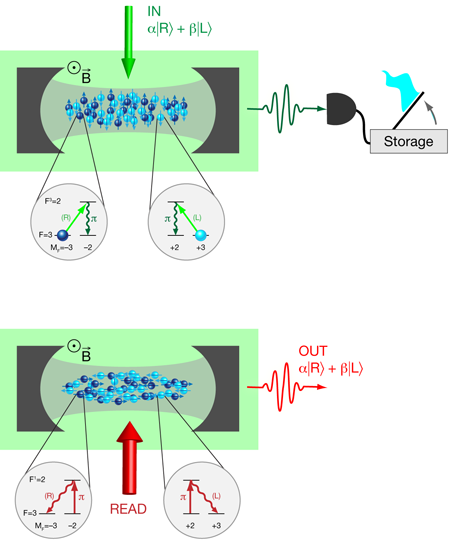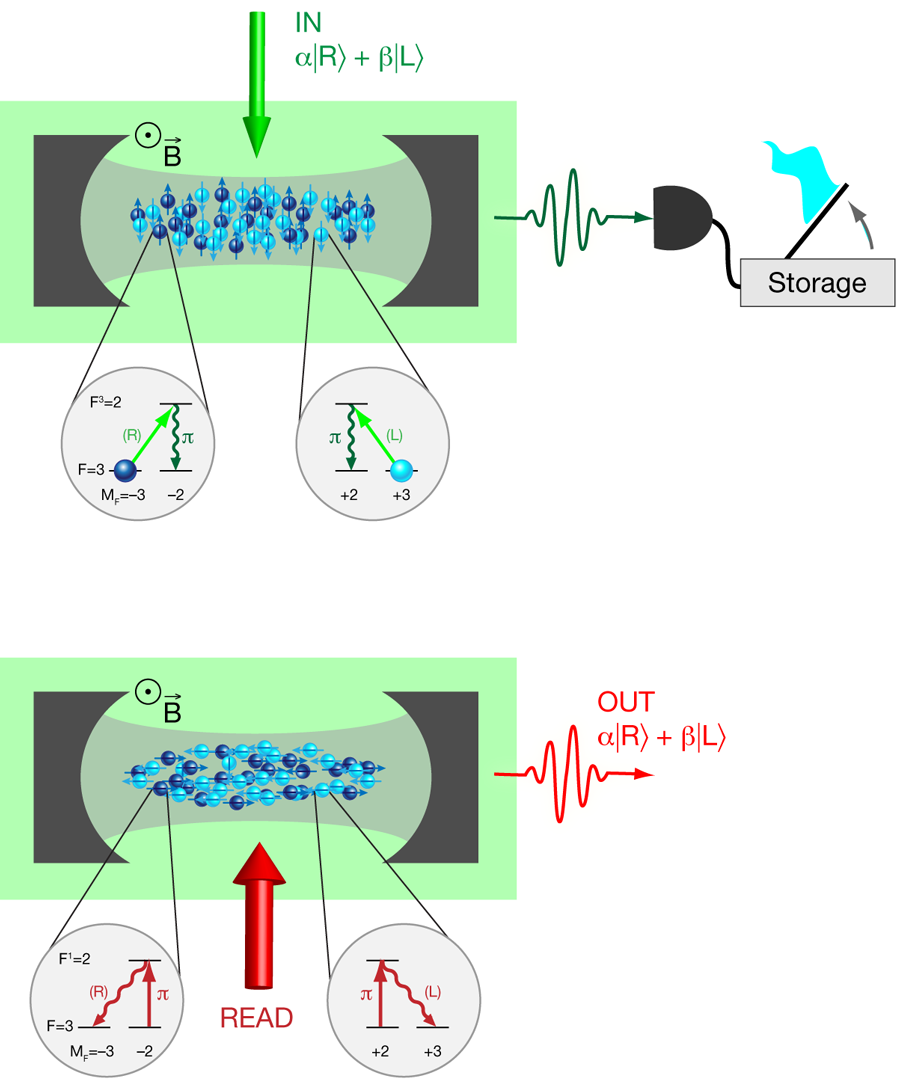Heralding the storage of light
A quantum network, a possible precursor of a “quantum internet” [1], relies on mapping the quantum state of a light pulse onto nodes in material systems. In recent years scientists have studied different materials and architectures with the aim of addressing this goal. Catching a beam of light is a central piece of this puzzle; “heralding” it, i.e., finding a signal to know that it has been caught, is more difficult. In a paper published in Physical Review Letters, Haruka Tanji, Saikat Ghosh, Jonathan Simon, Benjamin Bloom, and Vladan Vuletić at MIT, in the US, demonstrate an atomic quantum memory where the successful storage of a light beam is heralded [2]. This capability will likely benefit scalable quantum networking, where it is crucial to know if operations have succeeded.
Over the last two decades the quantum information community has been challenged by how to connect light and matter at the single-photon level. A large ensemble of identical atoms is a much-studied environment promising support. (For a review of work in this area, see Ref. [3].) In 2001, a proposal by L. M. Duan, M. D. Lukin, J. I. Cirac, and P. Zoller [4]—the so-called DLCZ protocol, based on a three-level scheme with two ground states and one excited state—boosted this broad effort. A “write” laser pulse (attenuated, but still with many photons) induces spontaneous Raman scattering, transferring atoms from one ground state (where they initially reside) to the other (which is empty to begin with). For a very weak laser, the detection of a single photon in a given spatial mode heralds that a single atom has been transferred but we don’t know which atom. A collective state is thus produced with a single excitation—a single “spin flip”—across the whole ensemble. Later a “read” laser beam can transfer this atomic excitation into another photonic mode. However, this collective situation is fundamentally different from that which occurs with a single atom, which emits in random directions and is difficult to pin down. Here, the scattering event is collectively enhanced due to many-atom constructive interference, and the conversion of the single excitation to a single photon occurs in a well-defined spatiotemporal mode. Such a single collective “spin” state has sometimes been called a magnon, as in the present paper by Tanji et al. This technique and subsequent developments have led to efficient sources of single photons, entanglement between remote atomic ensembles, and even to demonstrations of a rudimentary quantum repeater segment [5,6].
For a quantum network it is also useful to store the quantum state of an incoming pulse of light. This is a different goal than those of the previous protocols where the nonclassical state is built-in, but one that still involves a large sample of atoms and a collective effect. Some groups have succeeded by storing, for instance, a single photon in a memory [7,8] or entangled beams into two separate memories [9]. They used a quantum phenomenon known as electromagnetically induced transparency (EIT), where the power of an additional light beam controls the storage and retrieval. In this case, the storage is not heralded. For scalable networks, the entire process has to be done deterministically, an alternative to heralding a signal but an extremely challenging goal.
Missing in this family of protocols is the ability to imprint a light pulse into the ensemble, like in an EIT protocol, while emitting a heralding signal, like in the DLCZ approach. Even if the input light suffers significant losses, the heralding will effectively “regenerate” the state by announcing the success. This is the motivation of the experiment performed by H. Tanji and co-workers, where they store in a heralded fashion the polarization state of an input beam of light and retrieve it later.
In their experiment, they first load cold cesium atoms from a magneto-optical trap into a one-dimensional optical lattice, reaching temperatures around (see Fig. 1). They then optically pump more than of the atoms into two opposite extreme Zeeman states of a particular ground state. At the end of the preparation stage, they obtain two large spatially overlapping ensembles of around 8000 atoms each. The ensembles have rather different absorption properties: when the write light shines on them, the first ensemble absorbs only left circularly polarized light, while the second absorbs only the right circularly polarized light. Any input light polarization can be expressed as a coherent superposition of these two circular ones with different weights and relative phase. The idea underlying the proposed scheme is to create a single collective excitation as explained above, but now coherently shared between these two ensembles with the same weights and phase as the incoming light superposition.
How did the authors herald successful storage? Here comes the subtlety of the scheme—both absorption processes can result in the emission of a photon of the same polarization, same color, and inside the same spatial mode, making the two emission paths indistinguishable. This detection event heralds the storage. The input polarization has not been revealed in any way but it is stored in the memory, and a flag, so to speak, has been raised.
The authors then fire a read pulse into the ensembles after a delay of . Due to the collective enhancement, the two ensembles reemit along the same polarization that they absorbed. In the ideal case, the atomic excitation is thus converted “on demand” to a single photon with around efficiency with a one-to-one correspondence with the write polarization.
Does it work better than a classical system? This question can be answered by considering the most efficient classical strategy: measuring the input state and reconstructing it later. This strategy offers only a limited success, as it is impossible to completely characterize an unknown state. To check the quantum feature of the memory, the authors input different polarization states and retrieve them. By comparing the input and the output polarizations, they confirm that their system outperforms the classical limit. In the present experiment, they attain “fidelity” as high as .
This calls for subtle and exquisite control capabilities. The atoms are first loaded into a cavity that enhances the matter-light coupling in the heralding and retrieval process. The MIT group took this step a few years ago, which enabled them to reach very high retrieval efficiencies [10]. But this is not easy for the polarization scheme involved here. The write beam and the read beam come from the side of the cavity, and they need to address different transitions, for the first and for the second. The atomic spin has to be rotated by between them for this to work. A magnetic field is thus applied to induce Larmor precession: the macroscopic spin is orthogonal to the cavity axis during the write process and then aligned with the cavity during the readout stage. The applied magnetic field has to be very homogeneous, or else it would induce inhomogeneous broadening and cause decoherence of the single-excitation superposition, thus drastically reducing the memory time. Thanks to these controls, the authors are now able to address the atoms from different directions, with different polarizations, and at different times.
This research pushes forward the more and more complex control experimentalists have nowadays to address the quantum state of atoms and light. However, in a quantum network with nodal interconnections, the polarization of a single photon (a quantum bit, or qubit) needs to be stored. Here, the input still involves many photons as the count rates are too low; the success rate of storage for an incoming photon is currently limited to without taking into account the detection efficiency. Whether a second resonator on the input field will allow extension of this scheme to qubits remains to be seen. Increasing the storage time would also of course be of great benefit, and encouraging results have already been obtained by other groups reaching the millisecond range [11,12].
Sophisticated quantum networks—with interconnected heterogeneous nodes and channels working by quantum logic—are a faraway dream. However, the quest is leading to a blooming and maturing line of research. Conceptual advances and exquisite experimental controls, such those shown in this paper, will lead to surprises, applications, and practical devices.
References
- H. J. Kimble, Nature 453, 1023 (2008)
- H. Tanji, S. Ghosh, J. Simon, B. Bloom, and V. Vuletić, Phys. Rev. Lett. 103, 043601 (2009)
- N. Sangouard, C. Simon, H. de Riedmatten, and N. Gisin arXiv:09062699
- L.-M. Duan, M. D. Lukin, J. I. Cirac, and P. Zoller, Nature 414, 413 (2001)
- C.-W. Chou et al., Science 316, 1316 (2007)
- Z.-S. Yuan et al., Nature 454, 1098 (2008)
- T. Chanelière et al., Nature 438, 833 (2005)
- M. D. Eisaman et al., Nature 438, 837 (2005)
- K. S. Choi, H. Deng, J. Laurat, and H. J. Kimble, Nature 452, 67 (2008)
- J. Simon et al., Phys. Rev. Lett. 98, 183601 (2007)
- B. Zhao et al., Nature Physics 5, 95 (2008)
- R. Zhao et al., Nature Physics 5, 100 (2008)





